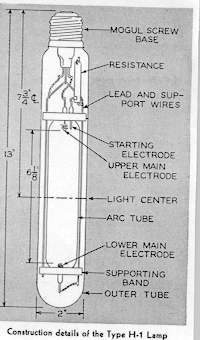
H-1 400 mercury lamp
GENERAL INFORMATION
Mercury lamps are all based on the operation of an electric discharge tube generally made of quartz or fused silica and containing mercury vapor under pressure. In most cases liquid mercury is not present in its arc tube during lamp operation.
The color and luminous efficacy of mercury lamps primarily depends upon the vapor density within the lamp's arc tube. Color can be modified by use of phosphors by the addition of other elements to the discharge, such as adding incandescent light from self-ballasted lamps. Mercury lamps are chiefly used for general outdoor lighting, especially street and highway illumination; as well as some use in projection and other special applications.
Principle of Operation
The operation of electric discharge lamps is based on the "collision" process among electrons, atoms and ions within the discharge tube. Ionization of atoms is required to allow current to flow to the lamp. Excitation of atoms or molecules is necessary for the subsequent emission of light. The principle wavelengths of mercury are in the ultraviolet and other spectral lines in the blue, green and yellow regions. The effect of vapor pressure can be seen when the lamp is initially energized. The electric discharge fills the tube and appears blue. At this time the discharge is similar to that of a fluorescent lamp and a relatively high portion of the emitted radiation is ultraviolet. With time, the temperature of the discharge tube rises and so does the pressure of the mercury; the discharge itself gradually becoming more intense. As the lamp further warms up with the internal mercury pressure within the arc tube on the increase, the light from the discharge becomes brighter and whiter.
Perhaps the most commonly known mercury lamp has an elliptical or ellipsoidal outer envelope coated internally with phosphor. The arc tube discharge emits the typical bluish/green-white together with some ultraviolet energy. The outer envelope and phosphors inside of the bulb absorb this ultraviolet and convert it to visible light. The phosphor typically emits red light because the discharge itself provides little in this range. The combined light is of reasonably good color rendering suitable for street lighting, industrial high-bay lighting and some commercial interiors. Lamp efficacy is usually between 35 and 60 lumens per watt, depending on the phosphors employed and lamp wattage. The latter range from 50 through 1,000 watts in most instances. For street lighting applications, lamps 100 watts and above have been and are employed.
Among the earliest mercury lamp types was the "Type H". The discharge tube was made of aluminosilicate glass and operated within a tubular outer bulb, two inches in diameter and 11 to 13 inches in length. This mogul base lamp was rated at 400 watts and was made commercially available about 1936. It had a light output of about 16,000 initial lumens (requiring about seven minutes to come to full brilliancy) with a life expectancy of 3,000 hours. It operated at low pressure and became obsolete during the 1950's owing to the more efficient quartz arc tube lamps, introduced in the 400-watt size about 1948 or 1949. These were classified as EH-1 lamps. The glass arc tube lamps were designed for either base up (AH-1 lamp) or (BH-1) base down operation unless an arc-centering magnet was wired in electrically in series with the lamp within the luminarie. The quartz arc tube lamps that had been manufactured only in the lesser wattages through the 1940s offered longer life, universal burning position and higher lamp efficacy. Initially the 400-watt version was more costly than the old design but eventually quartz arc tube mercury lamps (especially in the 250 and 400 watt types) became the standard by the late 1950s. The quartz arc tubes in these lamps could withstand the higher operating temperatures and increased internal arc tube pressure of the mercury discharge. Early versions were enclosed in clear tubular outer bulbs with a slight, straight-sided bulge to them (most 400 watt ones of this version were designated with a T-20 outer envelope). Color corrected lamps 400-watt lamps (originally designated JH-1) became on the scene about 1950 and these were of the familiar bulged tubular outer bulb design, (BT-37) identical to those some manufacturers still offer to this day. Depending on customer and lighting requirements, clear mercury lamps have been installed through the years and still are. Although they do not provide the improved color rendering qualities that the phosphor lamps do, significant attributes of clear lamps are superior optical control and their strong emission of green, blue and yellow light which is advantageous for landscape and some sign lighting, as well as black light applications where a special purple filter is installed over the lamp.
The self-ballasted mercury lamp is a combination of a discharge tube and a tungsten filament operating in series. It is connected to regular line voltage, typically 120 or 240 volts. The filament controls the current through the discharge tube so that a ballast is not required. These lamps also contribute to the light output by providing the red emission that the mercury discharge lacks. Most self-ballasted mercury lamps include on the inner surface of the outer bulb a coating of phosphor, which further improves color rendition. Self-ballasted lamps are more costly than ordinary mercury lamps and are not quite as efficient. Their primary advantage has been increased efficacy compared to incandescent lamps and long lamp life, typically 12,000 to 16,000 hours; making quick and easy upgrades from incandescent to mercury vapor lighting. Self-ballasted mercury lamps have seldom been utilized for street lighting but rather in commercial applications. More detail regarding this lamp type appears later, in the following chapter.
Manufacture and Construction of Mercury Lamps
The primary component of this lamp is its discharge tube, fabricated from fused silica, often referred to as quartz. This material can satisfactorily be used up to about 800 degrees C, but beyond this temperature changes are likely which can result in decomposition of the tube and lamp failure. This can be aggravated by contamination, particularly by alkali metals and it is important in lamp manufacture for the fused silica surfaces to be clean. Contaminants and moisture content within the material can affect the lamp, such as lumen maintenance and starting voltage, and it has been commonplace for manufacturers to wash and heat the tubes to 1,100 degrees C for several hours prior to lamp fabrication. In most lamps the fused silica operates well within its temperature limitations, the center of the tube being in the range of 600 to 750 degrees C depending on lamp wattage and its operating position.
A hermetic seal at each end of the arc tube must allow for the passage of electrical energy to the discharge. A suitable current carrying seal is made from by using molybdenum in the form of a thin foil of elliptical cross-section. The seals are made by welding the components together and inserting this into the end of the discharge tube, which is heated to about 2,000 degrees C and pressed into shape. The metal parts are meanwhile protected from oxidation by a flow of inert gas.
The main electrodes are principally manufactured from tungsten but contain some additives. The design and processing of them is crucial to lamp performance in terms of starting, lumen maintenance and lamp life. The typical form consists of a central rod which carries fabricated forms of tungsten; in some designs the rod does not extend to the end of the coil and in such cases the rod may be made of molybdenum, which is less expensive than tungsten and more easily welded to the coil.
The electrodes are typically impregnated by electron-emissive materials. Generally the emissive material consists of a combination of barium and strontium carbonates with other additives. This mixture is usually applied to the electrodes by a dipping process although the precise method of coating varies. The emissive material is retained in the spaces between the wire coils but the outer surfaces of the electrode are cleared of emitter to avoid its evaporation to the inside walls of the arc tube. Thorium metal has also been used as an electron emitter, but lamps are more difficult to start sometimes and end darkening may occur more readily. The electrodes are designed for easy starting of the discharge and optimum operating temperature of the tip of the electrode, where the arc typically extends from and of the portion of at the emissive material retained on the electrode, itself. The rod diameter, the length of the protruding tip the size and weight of the surrounding wire structure all affect the temperature of the electrode, and this in turn affects lumen maintenance and other factors such as stability, lamp extinction voltage and flicker. In general if the temperatures are too high, the emissive material evaporates, darkens the tube wall and reduces the light output, particularly in lamps of lesser wattages. On the other hand, low temperatures produce arc instability, poor emission and also may cause arc tube darkening. Electrode tip temperature during operation is typically between 1,500 and 1,900 degrees C and the outside windings between 1,000 and 1,400 degrees C.
The electrode is formed from wire derived from techniques developed in making incandescent lamp filaments. A more direct and economic method of manufacture is by powder metallurgy. Porous, sintered slugs of tungsten with selected additives are used in manufacturing effective discharge lamp electrodes.
To enable a mercury lamp to start a starting electrode of molybdenum or tungsten is mounted adjacent to one of the main electrodes but connected to the opposite main electrode through a resistor, typically in the vicinity of 40,000 ohms. When the lamp is energized the full supply voltage appears across the gap between the gap between the main and adjacent starting electrode; this breaks down into a glow discharge. The resistor limits this discharge. If the resistance is too high, a higher supply voltage is required to strike the main discharge. If the resistance is too low, energy is lost when the lamp is operating due to the shunting effect across the discharge.
Arc Tube Exhaust and Filling
The discharge tube after manufacture is exhausted of air and contaminants and filled with argon and a controlled quantity of mercury. In some manufacturing methods the discharge tubes are baked at several hundred degrees Celsius and the cathodes are heated to complete the exhaust process. The control of precisely filling the arc tube is important because lower pressures aid starting and higher pressures improve lumen maintenance. The filling process is completed by heating and then press sealing the filling tube in the form of a "drip point" which can be seen in the arc tube's center.
The amount of mercury varies with the lamp wattage but typically the amounts are 20 mg for a 100-watt lamp and 60 mg for the 400 watt. These quantities are precisely determined and are such that all the mercury is vaporized during lamp operation.
The Outer Envelope
Although mercury lamps are often seen in the bulged-tubular (BT) shape, the most common form of envelope is ellipsoidal. These shapes were introduced with the use of phosphors for improved color rendition from mercury lamps. Phosphors are not greatly affected by temperature and the outer bulb shaped for appearance and optical performance. Temperatures in the vicinity of 270 degrees C around the middle of the envelope are normal. The outer bulbs mostly are of hard borosilicate glass, which is more resistant to thermal shock and atmospheric deterioration. Reflectorized mercury lamps also have been manufactured for floodlighting and other specialized applications and these lamps usually employ phosphor coatings in the reflectorized portions of some lamps. Some consist of simply the reflectorized material, identical as employed with incandescent lamps.
In reference to applying the phosphor coating, a typical process is to prepare a suspension of the phosphor powder in an organic binder, such as nitrocellulose, with selected other ingredients. Suspension in water with an appropriate binder has also been used. The suspension can be applied to the inside of the outer bulb by a jet directed to the top of it, or by a spray method. Different manufacturers have used various methods. After internally coating the solvents are evaporated utilizing heat and airflow to leave a uniform dry coating of phosphor in the binder. Subsequently, the binder has to be removed by baking the envelope to about 600 degrees C in an oxidizing atmosphere, without leaving residues that could reduce the light output.
The method of location of the arc tube within the outer bulb is important regarding handling, and traffic as well as operation vibration. Typically the frames are made of nickel-plated iron, nickel or stainless steel. It is essential that all metal parts are clean and free from traces of grease. Prior to assembly the frames are usually cleaned to eliminate possible contaminants.
The mercury arc tube on its frame is sealed onto its outer bulb by heating the neck of the envelope and collapsing the glass onto the mating bulb stem flare. This joint is usually molded to a shape suitable for attaching its base. After sealing the lamps are exhausted of air and filled with inert gas, which protects the leads and seals from oxidation during life. The gas used is usually nitrogen or a nitrogen/argon mixture. The screw base is affixed to the neck of the lamp using a cement or mechanical locking method.
Electrical characteristics
The mercury lamp like most other discharge lamps has a negative resistance characteristic and some circuit element is required to control the current to the lamp. In addition, a discharge lamp requires a higher than line voltage to start than to operate and the external circuit must accommodate this difference. The type of ballast required depends on the lamp wattage and line voltage leading into the ballast. In some instances this is simply accomplished by installing the appropriate ballast in series with the lamp, sometimes with a capacitor in parallel with the line for power factor correction. Mercury lamp ballasts consist of several differing electrical configurations, each dependent upon customer requirements and lamp wattage.
The starting of a mercury lamp is affected by numerous factors, including discharge tube length and diameter, gas filling and pressure, and auxiliary electrode spacing. The longer and narrower the tube the more difficult the starting becomes. Since at ambient temperatures the vapor pressure of mercury is very low, an inert gas is necessary to initiate the discharge. Argon is typically used so that higher starting voltages occur at lower temperatures.
The auxiliary or starting electrode is necessary for reliable for starting on power supplies 240 volts and less. At room temperature and without the starting electrode a lamp would require well over 240 volts to start. The gap between the main and starting electrode is especially important for lamps of shorter length. For very low temperatures lamps with a starting electrode at each end have been manufactured in past years.
Mercury lamps are sensitive to supply voltage and line fluctuations and depending on the ballast type, the lamp will extinguish upon the loss of just a cycle or two upon the ballast's primary. When the lamp is turned off of affected by power interruption the pressure within the mercury arc tube drops gradually as it cools. In order to restart it instantly at its operating pressure is several thousand volts. Quicker restarts can be accomplished by utilizing a starting aid providing pulses of these higher voltages but this is not practical because of potential arcing or electrical breakdown within conventional mercury lamps. The time required for the lamp to cool and restart conventionally depends on ambient conditions but generally it is in the order of three to five minutes. For installations where such illumination loss potentially is a safety concern, particularly in commercial and industrial interiors, incandescent and fluorescent lamps have been utilized as an automatic or existing back-up lighting source in the event of such outages.
Light Output
In designing a mercury lamp the most essential requirement may be a specified lumen output or, as in most cases, wattage. The designed tube voltage typically is about 60 percent of the supply voltage; a compromise between being as high as possible for good circuit efficiency but low enough to avoid discharge instability with fluctuations in the power supply. The amount of mercury within the lamp is a direct function of the required tube voltage, the tube length and diameter.
The maintenance of light output during life is determined primarily by the electrodes and lack of contaminants in the lamp. Sometimes lamps of lower wattage are poorer in maintenance, chiefly due to the effects of end darkening on their short tubes and the proportionately larger effect of included contaminants. While depreciation of light output is more rapid initially, the rate throughout life is typically around two to three percent per 1,000 hours, but this estimate varies with lamp rating and operating conditions and may very slightly be reduced (or nearly stabilized) in lamps during mid-life of long lived lamps that have seen in excess of 100,000 hours of use.
An inherent characteristic of mercury lamps is for the discharge to flow upwards, from electrode to electrode. Thus, when operated horizontally, the arc stream has a tendency to bow vertically upwards somewhat. Horizontal operation slightly reduces light output, however this change is unnoticeable. To offset this light reduction, for those who were concerned, some manufacturers produced mercury lamps that operated at a small increase in wattage. For instance a special 425-watt lamp replaced a 400 watt one and provided the same amount of light as the standard 400 watt when operated in vertical position. The practice of employing over-wattage mercury lamps was not common and manufacture of them mostly was during the 1960s.
Lamp Life
Failure to light normally is due to loss of emission from the electrodes and on account of this alone, individual lamps can burn tens of thousands of hours in many cases. Rated life for mercury lamps has been in the order of 24,000-plus hours since the late 1960's according to most manufacturers' publications, so indicating that two-thirds of lamps in a given installation are expected to still be operating at 24,000 hours. In some instances mercury lamps have continued to provide a surprisingly good percentage of initial light output after over 100,000 burning hours. Useful life is primarily dependent on the depreciation of light output and the rate of failure of lamps in an installation. Because of the high cost of replacing individual lamps in some multiple installations, group replacement at a specified percentage of rated life may be more economical only in these cases. Typically in street lighting applications the trend has been through the years to replace mercury lamps upon burn out, rather than group replace them. The results are mixtures of various ages of lamps in larger installations. Along with new and relatively recent replacements, mercury lamps having seen 25 to 30 years of use upon them have not been uncommon during observation and field studies conducted. As mentioned, a satisfactory amount of light can be sometimes be expected from these long-lived lamps; however they gradually color shift (losing some of their bluish-white, depending on individual lamp phosphor) more toward green to a sometimes characteristic greenish-blue as they age.
Self-ballasted Mercury Lamps
The filament within these lamps is designed to contribute light and control the current, acting as a resistor. It is mounted adjacent to the arc tube to achieve mixing of light and to reduce warm up time, which is important to the lamp's light output and life.
Self-ballasted mercury lamp manufacture includes techniques similar to incandescent lamp making. Getters (specially-made metal components which absorb gaseous contaminants thus preventing interior bulb darkening during operation) are used for any such gases present, while the gas filling within the envelope is usually a nitrogen-argon mixture to provide low thermal losses and minimize filament evaporation.
Self-ballasted lamps are designed to provide a ratio of approximately 4 to 1 mercury to incandescent light, in order to achieve a high luminous efficacy and rated life, which is in the order of approximately 12,000 to 16,000 hours, depending on type. Phosphors are usually incorporated to provide additional red light, providing good color rendition.
Upon starting when the arc tube voltage is low, the voltage across the filament constitutes the majority of the supply voltage while in stable operation; when the arc tube voltage is higher the filament voltage is 40 to 50 percent less. Clearly the design of the filament must be a compromise between the required luminous efficacy in steady operation and the effect on life of the increased voltage during starting and warm up. The filaments are typically designed to operate between 5 and 7 lumens per watt. Because the filament of the self ballasted lamp characteristics with varying supply voltage are slightly different than those of standard mercury lamps, the effect on life is more severe than with incandescent lamps. Voltage supply or cycle dips will extinguish the operation of the lamp's arc tube. However, self-ballasted mercury lamps will re-illuminate instantly in such cases since the lamp's filament provides the entire light output until the mercury discharge tube has cooled to the point where it can re-ignite. This may take some time because the adjacent heated filament retards the arc tube cooling process.
The primary application of self-ballasted mercury lamps has been as an alternative to incandescent lamps in commercial and industrial lighting where the increased efficacy and longer life are advantageous, or for low initial cost installations where mercury lamps would ordinarily be desired. Streetlighting installations in this country of these lamps have been very limited and rare. Lamps are available in the traditional pear-shape (PS) envelopes, as well as similar in size and shape to standard bulged-tubular and elliptical mercury lamps. Reflectorized lamps have also been manufactured, particularly in the larger sizes. Typical wattages are 160, 250, 450 and 750 with lumen outputs of 2,300; 5,000; 9,100 and 14,000 respectively.
Mercury-Vapor Streetlighting and Lamps
This very popular light source was first developed about 1901 and was known as the Cooper-Hewitt lamp and operated at low mercury vapor pressure in an elongated glass tube that was about an inch in diameter and four to five feet in length. The Copper-Hewitt lamp was the predecessor of the smaller, more compact and higher intensity mercury lamps that operated at increased internal pressure, introduced and commercially available in 1936.
Early lamps of this improved type consisted of a glass arc tube enclosed within a two-inch diameter tubular outer bulb. These 400-watt lamps typically were 11 to 13 inches long, had a mogul screw base and their light output was nearly two-thirds of today's clear 400-watt mercury lamp. The later 1930's mercury lamps were very expensive and had rated average lives of approximately 3,000 hours and required a ballast designated as the H-1 type. The advantage of mercury vapor lighting in its early days was the fact that they provided twice the light as an incandescent lamp of the same wattage and lasted three or more times longer. The characteristic bluish-green light emitted from these clear lamps resulted in poor color rendition, so applications were typically industrial lighting and occasionally streetlighting. For indoor purposes these early mercury lamps were utilized in fixtures specially designed to incorporate incandescent lamps as well, for better color correction. Following the 400-watt design were the 100 and 250 watt mercury lamps, introduced about 1940. Ballasts that operated these were designated H-4 and H-5, respectively, and these lamps also were of the tubular design. Like the 400's, they saw very limited streetlighting application in their earliest days. The 100-watt lamp had a quartz arc tube and T-10 outer bulb (about four inches long and 1-1/4 inches in diameter) and remained unchanged for many years. It also had an admedium screw base. Two varieties of the 250-watt lamp were manufactured: one had no outer bulb, limiting it to locations where it would not be susceptible to cold drafts (indoor applications). The other also was tubular, however it had a glass arc tube and outer bulb like the 400-watt version and was identical except for being a few inches shorter. This mogul base lamp was used for streetlighting but very uncommonly. Photographs of these vintage lamps accompany this website.

H-1 400 mercury lamp
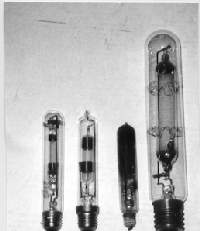
250 Watt mercury lamps (1940's) and 1940's 400 watt mercury (on rt.)
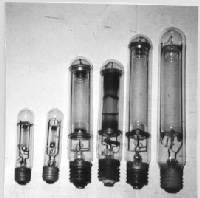
Mercury lamps circa 1940's-1950's 100, 250 and 400 watts
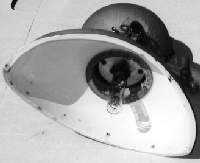
Wheeler 100 watt mercury (Admedium base lamp), 1953
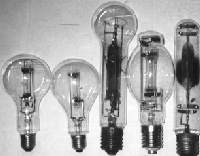
Various specialty mercury lamps 1940's-60's
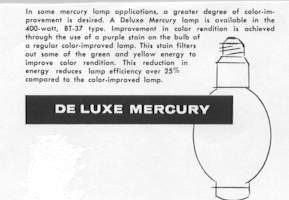
GE mercury lamp bulletin 1962
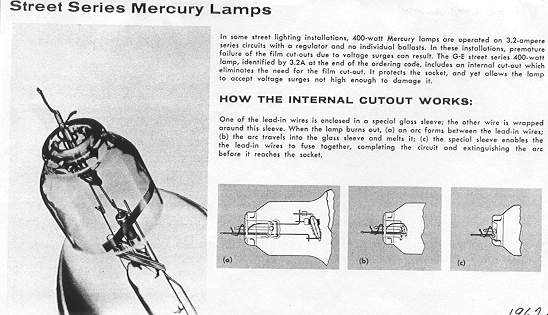
1962 GE Lamp bulletin

1950's Mercury Street Lighting Lamps
After World War II mercury streetlighting began to significantly increase in popularity, likely on account of more roadways constructed and the presence of many more automobiles on the nation's highways. 1948 was a revolutionary year for mercury lamp progress and new luminarie designs specially developed for mercury illumination. During that year a 400-watt mercury lamp became available that employed a quartz arc tube, permitting operation in any position. This design was known as the "E-H1" and was smaller and intrinsically brighter than the glass arc tube design and lasted longer. This lamp was semi-tubular in design with a slight, straight-sided bulge to it and was more expensive than its AH-1 counterpart, which remained in production until the late 1950s. Both 400-watt mercury designs operated effectively from the same ballast. Throughout the 1950s, the EH-1 lamp gradually superseded the AH-1, as the former became less expensive, more practical and universal making it the standard for 400-watt mercury installations. By 1952, the semi-tubular EH-1 was redesigned into the familiar larger BT-37 outer bulb, which did not restrict as much heat within the bulb's enclosure, further enhancing lamp life.

1960's Mercury Vapor Lamps
Among the negative factors of mercury vapor streetlighting, as mentioned earlier, was their poor color rendition. In the early 1950s phosphor-coated- inside lamps were introduced which provided better color balance and less distortion. They were first offered in the 400 watt size that employed the larger BT-37 outer bulb, which replaced the slim, slightly bulged-tubular T-20 which could only be made in clear. In succeeding years, tubular streetlighting lamps were phased out, replaced by somewhat larger lamps that accommodated internal phosphor. Some of these bulb styles remain in production to this day. Such "color improved" lamps were an option at added cost and were ideal for installations where color rendition was more critical such as in parking lots. Clear mercury lamps generally were the rule through the late 1950's for general streetlighting when the price difference between the clear and phosphor ones became less dramatic. Beginning about 1960 "color improved" phosphor lamps were standard for most streetlighting applications in many portions of the country.
SPECIALTY MERCURY STREETLIGHTING LAMPSAmong the non-standard mercury lamps designed for streetlighting during the late 1950s and early 1960s were the "deluxe white phosphor" and "caution yellow" lamps.
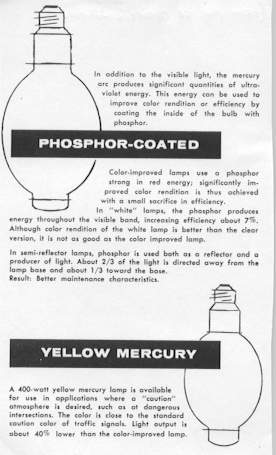
1962 GE Mercury lamp catalog
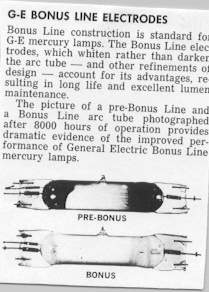
1966 GE Mercury lamp bulletin
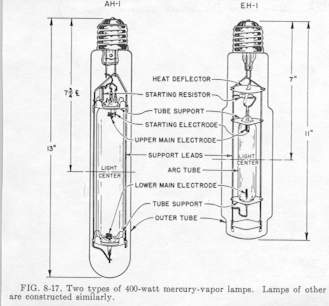
1952 Illuminating Engineering Society Manual
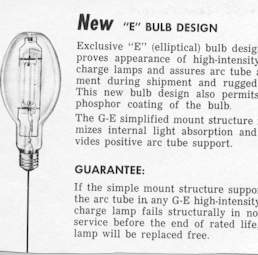
1966 GE Mercury lamp bulletin
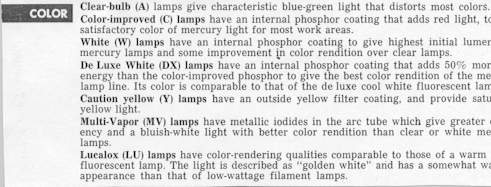
1966 GE Mercury lamp bulletin
Offered by the most prominent mercury lamp manufacturers beginning about 1960 or 1961 were the deluxe white mercury lamps which provided highest possible amount of color rendition. This was accomplished by applying a special reddish-purple coating upon a standard color improved mercury lamp, making otherwise "mercury-weak" colors such as red much more apparent. Despite much better color balance than the standard color improved lamps, a small amount of light output efficiency was sacrificed. Deluxe white mercury lamps with this coating were rare until 1964 when a revolutionary internal phosphor was developed that provided equal or better color rendering than the coated lamps with a bonus of somewhat higher luminous efficiency than the color improved and clear mercury varieties. This new phosphor was white and is much the same as used in making today's deluxe white lamps. Even though color- improved lamps were made into the 1970s, the majority of phosphor mercury lighting in streetlighting practice has been the employment of deluxe white lamps.
Caution Yellow LampsIn areas where dangerous intersections existed mercury lamps providing distinct, saturated yellow light very similar to a yellow traffic light were utilized in various parts of the country. These lamps were produced by General Electric, Westinghouse and Sylvania beginning about 1958, continuing through the middle 1960s. Some were coated with a heat-resistant, transparent coating and others, such as those made by Sylvania, employed a distinct yellow phosphor. Typically, "caution yellow" mercury lamps were of the 400-watt size. Most of the externally transparent coated lamps were internally phosphored and it is known that clear lamps with this coating also were manufactured. An approximate 40 percent in light output reduction took place by using these lamps compared to their clear and phosphor counterparts. The demise of the yellow mercury lamps probably was due to the reduction of their light output and the introduction of high pressure sodium streetlighting luminaries in 1965.
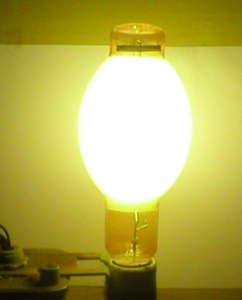
Illuminated "Caution Yellow" Lamp
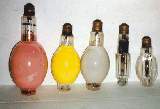
Unusual 1950's and 1960's Mercury Street Lighting Lamps
Streetlighting mercury lamps mostly were of the familiar BT (bulged- tubular) outside bulb design by the late 1950s since the tubular glass arc tube lamps were just about obsolete by then and those with quartz arc tubes had become the industry standard. In 1966 General Electric introduced a substantially different outside bulb for all of their mercury lamps rated 100 through 400 watts. This shape was and is known as the "elliptical" shape and continues in production to the present. They claimed that the advantages of this new bulb design was improved, simplified lamp appearance and elimination of the "unsightly" bare or clear bulb end inherent with BT shaped mercury lamps produced up until then. General Electric discontinued production of their BT 100, 175, 250 and 400 watt lamps at once, although the BT style was (and still is) available as an internally phosphored option for their 400 watt mercury lamp. 700 and 1000-watt mercury lamps continue to be made in the BT shape. Other manufacturers were slower in adopting the "elliptical" or "E" designated lamp enclosure through the years. In the early 1980s Sylvania introduced the elliptical design only in their 100-watt size, replacing the former BT-25. All other mercury lamp sizes continued to be of the original BT shapes. Westinghouse continued production of all of their tried-and-true BT lamp configurations until Philips purchased the company in l985. It was not until 1988 when all Westinghouse-Philips 100-400 watt mercury lamps were gradually and eventually manufactured in the elliptical shape.
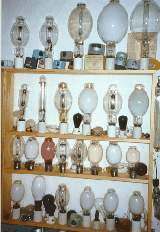
View of portion of mercury lamp collection (most 1960's and earlier)
Of interest, fully phosphored (to the lamp's end) BT lamps were put into standard production by Sylvania and Westinghouse during about 1975. For a short period during mid-1972 Westinghouse manufactured a few fully phosphored 175 watt, BT shape lamp mercury lamps but for some unknown reason they quickly resorted back to the clear-ended variety for the following three years. Perhaps the 1972 fully phosphored lamps were experimental?
MERCURY LAMP EFFICIENCY AND RATED LIFEAs any electrically operated lamp ages it gradually produces less light output (an exception are some low pressure sodium lamps) and this is especially true for mercury lamps. Commencing in the early 1960's an industry-wide campaign was in full force as competitors attempted to develop mercury lamps with arc tubes that actually whitened instead of turning black or grayish-black as operating hours accumulated upon them. Arc tube blackening that resulted in deteriorated light output was among the drawbacks of utilizing mercury lighting. As the mercury streetlighting rage started to really catch on during the late 50s-early 60s, lamp manufacturers found it to be imperative that their lamps performed brightly as they remained in service throughout their rated lifetimes. Indeed, they were for the most part successful, making mercury lighting more attractive literally and economically by the early 1960s.
Supplementing efforts in producing lamps that provided improved color rendition and better light output maintenance, mercury lamp manufacturers also were striving to make their lamps even more practical investments by developing technology that made their lamps last longer. Earliest mercury lamps had an estimated longevity of 1,000 to 3,000 hours, depending on lamp type and wattage. By the late 40s this had been increased to 5,000 to 6,000 hours and by 1960 rated lifetimes were in the order of about 8,000 to 10,000 hours. By 1962-1963, 12,000-hour lifetimes were the standard among the manufacturers; soon upgraded to 16,000 hours by 1964 and 24,000 hours by 1966. Since lamp replacement was advertised to be far less frequent and lumen output was guaranteed to only slowly decrease with lamp life, mercury lamp manufacturers found business thriving in the 1960s as utilities and other commercial lighting users placed a great many orders for mercury lamps. The manufacturers had invested millions of dollars into research and development for mercury lamps that would retain such good light output and last a long time; and they certainly were successful in these pursuits. Little did they know at the time, mercury lamp life eventually far exceeded their expectations. This startling fact was not discovered until some years later. The majority of mercury lamps placed in streetlighting service during the 1960s lasted well into the 1970s and some into the 1980s. Not so rare scatterings of them were still in existence in the 1990s, representing well over 100,000 hours of operation in most instances! Westinghouse, General Electric, Sylvania and others made these incredibly long-lived lamps. In addition, some of the lamps sampled with over 20 years of streetlighting service upon them still produced an impressive amount of light in the majority of instances. The author gathered this information from observing large groups of mercury lamps removed from service and discussions with their manufacturers. One representative mentioned that "Yes, we have had a problem with the mercury lamps we made in earlier years..." meaning that obviously a very large amount of money was lost by producing lamps that should have failed within a predictable amount of time but did not. Although planned obsolescence was intended, it simply did not happen as expected, so orders for replacement lamps simply were significantly less than expected in the 1970's and beyond. Further discussion with this representative revealed that the 175 watt lamps seemed to last the longest, but that can be contested. He also mentioned that a probable maximum life expectancy for a mercury lamp would be somewhere in the order of 175,000 burning hours. The author knows of several 175 watt mercury lamps in one community installed in 1965 that are still operating as of 1998, providing unnoticeable light output depreciation. There probably would be many more old original installations like this if it had not been for HPS conversions and in some areas, group lamp replacements. In front of my home is a utility-owned 100-watt mercury fixture installed around 1977. Having lived here 20 years, the lamp inside it has never burned out and does a very good job lighting the adjacent area. Maybe if the luminarie does not get changed to HPS, the lamp will outlive me? Apparently it was not until sometime in the 1970s when the lamp manufacturers discovered that the mercury lamps they had been making were exceedingly well overbuilt and that there were too many of them in service that should have burned out years earlier. By the early 1980s and continuing to the present mercury lamp mortality is approximately as published since there obviously was a campaign among manufacturers to "redesign" the mercury lamp so that it failed within its rated lifetime. Approximately 5 percent of mercury lamp installations installed in the 1960s with 120,000 or more hours can still be expected to be presently in service. Of additional interest, a small amount of color shift occurs with long-lived mercury lamps, making them somewhat easy to spot at night. In addition to a bit less light output, the clear ones tend to be more of a distinct greenish-blue; the deluxe white lamps look crispy light bluish with sometimes a hint of green; and color improved lamps definitely more greenish, often like what you would see if you put a standard compact fluorescent or soft white incandescent lamp inside a cut open green plastic soda bottle.
Manufacturers of mercury lamps were proud of their products because of the research and development they invested in them that made them stay brighter, provide improved color rendition and last longer. General Electric's trademark for their mercury lamps was "Bonus Line" from 1961-1965; Sylvania's was "Banner" from 1960-1963 and Westinghouse designated their mercury lamps as "Lifeguard" from about 1961 through 1985. Earlier (1958-1961) Westinghouse mercury lamps were marked "Weather Duty"; apparently on account of the fact that their hard glass, weather-resistant outer bulbs (other manufacturers employed similar glass during that period but did not apply a trademark on their lamps for this attribute). Mercury lamps can be dated by inspecting these trademarks stamped on the lamps' end. Date codes were also affixed to the lamp so that the month and year of manufacture can be determined. To explain the methodology used by each manufacturer would take some time and length here. If you have a mercury lamp and would like to know when it was made, please contact me and I will do my best to decipher the code (usually two numbers or an alphanumeric combination) stamped on it.
Straight Series Mercury Lamp OperationFor a short period during the late 1950s and early 1960s General Electric and possibly some other prominent lamp manufacturers produced mercury lamps that operated directly within the series circuit like incandescent series lamps without utilizing an isolation transformer at each luminarie location. The ballast or voltage regulating mechanism was the constant current regulator at the head of the series circuit, just like in other series installations. The advantage of this system simply was economics: mercury lamps could be operated in series without any auxiliary equipment associated with each luminarie. Basically, the high voltage series circuit wiring was connected directly to the lamp socket and a special lamp had to be utilized so that when it failed the two lead-in wires near the lamp's stem would instantly short together, maintaining continuity within the series loop. Since high open-circuit voltages are inherent with series streetlighting systems, heavily insulated, high voltage cable had to be connected right up to the luminaire's socket, which also had to be made to resist such dangerous voltages and internally short out when relamping. Momentary outages causing "hot restrike" within "straight to the lamp" series circuit installations had the potential of electrically flashing over all of the lamps in such circuits, thereby ruining them. A time delay mechanism had to be used to de-energize such circuits for several minutes until all of the circuit's lamps cooled down so that they could be safely relighted.
Most installations of this nature were along highways and employed 400-watt mercury lamps rated at 6.6 amperes. Due to their inconvenience and higher maintenance expense most of these installations were retrofitted with isolation transformers or converted to multiple operation by the late 1960s.
MERCURY LAMPS AND FIXTURES: 1940s - 1950s
Because of their additional expense, mercury streetlighting was not common through the early 1940s. Luminaries that utilized mercury lamps through the end of World War II were simply incandescent ones with the mercury lamp installed in the fixture and the ballast mounted on the pole, crossarm or when used on metal poles, in the base. Most pioneer mercury streetlighting installations utilized 400-watt lamps. The most commonly used type was known as the "AH-1" which meant that it could only be operated base up. The other, "BH-1" was for base down operation, such as for within globe-top ornamental poles. These designations were standardized among all mercury lamp manufacturers. The glass arc tube lamps could only be operated in the designed vertical position; never horizontally. The same was the case with the glass arc tube 250 watt lamp, until it was superseded by a quartz arc tube design in the early 1950's, making this new generation lamp more practical for streetlighting.
After World War II mercury streetlighting began to significantly increase in popularity, likely because of more roads being built and more vehicles on the nation's highways. In 1948, a revolutionary advance in mercury lamp progress was introduced which spurred development of improved luminaries specifically for mercury-vapor lighting. This advance was a new 400-watt mercury lamp with an arc tube made of quartz that permitted operation in any position. This new type of lamp had a semi-tubular design (which was soon changed into the more familiar "BT" or bulged-tubular style) and superseded the older glass arc-tube design by the late 1950s.
The pronounced popularity increase of mercury streetlighting during the late 1940's and subsequent years was also prompted by luminaries designed for mercury lamps. Of special mention are the General Electric Form 109 and Westinghouse OV-20, both being introduced in 1948. Some advertising illustrating these is within the "Catalogs" pages and several in-service photographs of both are within the "Mercury Vapor Streetlights" pages.
The Westinghouse OV-20 was designed for the universal operation position EH-1 400-watt mercury lamp while the General Electric Form 109 accommodated either the EH-1 or less expensive AH-1 lamps. Both fixtures had lamp sockets that positioned the lamp horizontally. The AH-1 lamp was utilized within the General Electric Form 109 luminaries by means of an optional "arc-centering" magnet that maintained the center of the AH-1's arc stream directly in the middle of the lamp's arc tube. Otherwise, without this fixture option, operating an AH-1 would result in very short lamp life since the arc stream would bow upwards, burning through and shattering the outer bulb. This fixture's "magnet" was simply a wire coil connected in series with the lamp and positioned a few inches above it within the luminarie's head. Quartz arc tube lamps were unaffected by this option. The Form 109 remained virtually unchanged until 1954 when it was superseded by the Form 400. The earliest of these fixtures also had arc-centering magnets as a luminarie option. The first Form 109s had two "ribs" indented on each side of their reflector canopy while later ones have several. By 1954 when streetlighting fixtures with integral tube-powered photocontrols were becoming more popular, General Electric produced a few Form 109 luminaries with this option. Integral photocontrols were much more popular with the Form 400; tube-powered ones initially (1955-1957) and those with twist-lock receptacles (1958-1960).
The Westinghouse OV-20 was first introduced as a single-walled, stamped aluminum reflectored luminarie and remained the same until 1952. During that year the company introduced a modified, heavy-duty version consisting of a cast aluminum body and separate internal reflector, somewhat similar in appearance to the earlier OV-20. Improved optics were included with the upgraded OV-20; the refractor utilized with these was more square opposed to rounded as used with the earlier OV-20. Earliest (1952-1954) OV-20 fixtures appear to have a U-bolt pipe slip-fitter while 1955 and later models employed square, detachable four-bolt pipe clamp that accommodated a 1-1/4 or two-inch diameter fixture arm. Like the General Electric Form 109 and separate-ballast Form 400, the Westinghouse OV-20 was also offered with a tube-powered photocontrol, built as part of the luminarie above the pipe arm slip-fitter. These were uncommon and typically were designed for Fisher-Pierce tube-powered photocontrols (circa 1954-1958). It is not known if Westinghouse made OV-20 luminaries available with twist-lock receptacles, however production of this luminarie (without photocontrol provision) continued until about 1964.
About 1950 lower wattage mercury lamps were introduced to streetlighting service. Among these were the quartz arc tube 100 and 250-watt lamps. The admedium-based, T-10 outer bulb 100 watt lamp was offered in fixtures that had an integral ballast by some manufacturers, opposed to luminaries accommodating higher wattage lamps that had bigger, bulkier ballasts that required remote installation.
A photograph illustrating a circa 1953 Wheeler Reflector Company 100 watt mercury fixture complete with the ballast within the luminarie's head employing an open porcelain-enameled reflector is shown within the "My Collection" pages. Luminaries using 250 and 400-watt mercury lamps with ballasts built within them did not become available until 1957 or 1958. A discussion describing these will follow. By 1955 mercury lamps of the 100-watt size designed for streetlighting were available with a mogul screw base, like other mercury lamps. Initially these were of the PS-25 design (same physical shape as a household, three-way mogul base lamp) until most manufacturers produced them in the BT-25 size by 1960. In 1957 an intermediate size mercury lamp was developed, rated at 175 watts. These also had mogul bases and some of the earliest ones had PS-35 outer bulbs (same size physically as a 2500 lumen incandescent street series lamp). These were soon superseded by the BT-28 size, as had been employed for the 250-watt lamps for the previous several years. The 175 watt mercury lamp became extremely popular for streetlighting and the BT-28 design remained unchanged for decades.
MERCURY LAMPS AND FIXTURES: 1960s (GE / Westinghouse)
There were numerous well known manufacturers of mercury streetlighting luminaries during the 1950s and 1960s, such as Joslyn, Revere, Pemco, Wheeler, Line Materials Industries (McGraw Edison after 1967); General Electric and Westinghouse. This chapter will focus upon the highlights of mercury streetlighting fixtures of the latter two organizations because the author is most familiar with them and their evolution and the fact they were among the leaders in the industry. More detail and discussion of all of the other manufacturers of these fixtures would take nearly a book-length dissertation. Within the streetlight collector's club on-line newsletter will be a feature concerning more specific details about General Electric and Westinghouse mercury streetlighting luminaries, as well as background concerning those of other manufacturers.
As mentioned earlier, the first mercury streetlighting luminaries with integral ballasts were the lower wattage ones (100-watt fixtures, starting around 1950; 175-watt fixtures, around 1955). These had smaller and less cumbersome core and coil ballasts that did not require capacitors that consumed more space, so it was practical to build an "all-in-one" fixture. Some of these early units had optional provision for a photoelectric lighting control (usually mounted on the top of the luminarie and were of the tube-powered design). Although these fixtures were costly they indeed were state-of-the-art in their day and a real convenience to utilities that employed them.
By late 1957 General Electric and Westinghouse (they may have been the first) made industry news headlines by offering 250 and 400 watt mercury streetlighting luminaries with internal ballasts and related electrical components. These were known as the M-400 and Silverliner fixtures, respectively. General Electric's new, internally ballasted M-400 closely resembled their remotely ballasted M-400 introduced in 1955 except the new model had an elongated cast aluminum housing with a two-inch diameter opening for the bracket arm and accommodations for the ballast and other electrical components (crammed into available space inside). Access to this area was accomplished by removing a topside cover, which had the optional provision for a twist-lock photoelectric lighting control receptacle. Some of the preceding (1955-1957) Form 400 luminaries had tube-powered photoelectric lighting controls (usually Fisher-Pierce) mounted upon the pipe arm's slip-fitter. Non-ballasted Form 400 fixtures produced from 1958-1960 had optional twist-lock photoelectric lighting control receptacles as an option. However, the new, internally ballasted General Electric Form 400 slowly gained popularity over their remotely ballasted counterparts.
Westinghouse's Silverliner also was quite similar to their remotely ballasted OV-25 with the exception that the luminarie was obviously larger, like the Form 400, so that the ballast, capacitors, etc., could be included within the fixture. The internally ballasted Westinghouse also had provision for an optional twist-lock photoelectric lighting control receptacle, adding to its convenience and maintenance. The Westinghouse Silverliner underwent some minor changes through the years but remained generally unchanged through the years in basic design through 1985. The luminarie's most significant modification was incorporation of a one-piece access door during the early 1960's, superseding the separate ballast assembly removal plate and refractor assembly that was mounted on a hinged frame.
General Electric's first internally ballasted Form 400 was a short-lived design (1957-1959). Sometime during the 1959 model year the company reconfigured the M-400 into a completely different fixture, with a single-piece access door, sometimes referred to as the "cobra head" design. Their M-400 changed very slightly in following years and is produced to this day (1998) in the same basic configuration. It definitely is a tried-and-true streetlighting and highway illumination luminarie! General Electric's M-250 introduced in 1960 which operated 100 through 250-watt mercury lamps was very much like the M-400 except for its smaller size. It, too, has undergone only minor physical changes since its inception and this one-piece access door fixture continues to be manufactured by General Electric as of 1998.
Mercury streetlighting fixtures designed not to employ ballasts were manufactured through at least the middle 1960s, unchanged physically since their introduction during the prior decade. For instance, Westinghouse produced their good old cast aluminum OV-20 through about 1964 and their unballasted OV-25 (introduced in the late 1950s) for a couple years later. Post-1960 unballasted mercury fixtures mostly were intended for 250 and 400 watt lamps for replacements and installations along highways where it was desirable to place the ballast separately within the metal pole's base, especially where series circuits existed. After such older design, non-ballasted luminaries were discontinued, fixture manufacturers offered standard luminaries without electrical components as an option.
Subsequent innovations made available by streetlighting luminarie manufacturers include General Electric's Power Door fixtures. These were introduced in 1966 for 400 watt mercury and high pressure sodium lamps and very shortly thereafter their smaller Power Door fixtures came upon the scene which accommodated their 100 through 250 watt mercury lamps. The General Electric Power Door luminaries were designed by utilizing the same basic physical configuration as their M-250 and M-400 one-piece access door counterparts. The exception was that the Power Door design employed two separate hinged doors: one provided access to the refractor, lamp and reflector; the other had the ballast and electrical components mounted onto it wired to a modular-like plug connecting the door to the main body of the fixture. In some instances where HPS upgrades have taken place, some utilities simply unplugged the ballast door, installed an HPS door and changed the lamp, completing the conversion. Ever since the Power Door was introduced, General Electric claimed that upgrading to more efficient HID light sources could be made easy and simple by performing the above procedure if you purchased the more expensive Power Door luminarie in the first place. This method of conversion was rather uncommon through the years because utilities found that a brand new fixture would provide clean, maximum lighting levels and the fact that the individual Power Door assembly with the upgraded ballast was almost the same in price as a new fixture.
The smaller 100-250 watt Power Door luminarie changed very slightly until it was superseded by a more boxy-shaped fixture, possessing the same conveniences, in the middle 1980s. The larger 400-watt Power Door luminarie, however, is still being manufactured as of 1998 and is virtually identical to the original! Two versions of the larger Power Door were offered through the years: one had the ballast, etc., mounted on the door as described above and a slightly less expensive version was offered whereby all the electrical components were installed up inside the fixture body like the M-400 series. Therefore, the rear-most hinged door provided for easy access to the electrical area so that the portion housing the refractor would not be disturbed. Vice-versa was true for more convenient relamping and optical assembly maintenance. General Electric's Power Door luminaries have been a big success since the day they came on the market. Millions of them have been installed in the United States and around the world. Their versatility and ease of maintenance have contributed to their popularity despite their slight increase in cost compared to their standard single-door models.
Larger lamps, namely the 700 and 1000 watt mercury and 1000 watt high pressure sodium required physically bigger fixtures. In response to the 700 and 1000 watt mercury lamps that were gaining popularity during the late 1950s, General Electric offered their M-1000 which was a single access door, internally ballasted luminarie introduced about 1959 or 1960. Westinghouse manufactured their OV-50 which was available in two very different designs. Their unballasted model was a heavy cast aluminum fixture, which could have been ordered with a tube-powered (Fisher-Pierce) or twist-lock photoelectric lighting receptacle. The first OV-50 luminaries of the separate ballast design were probably made initially about 1956 or 1957. Production of these likely continued into the early 1960s, when their internally ballasted OV-50 became available. The latter underwent various subtle but noticeable design changes through the 1960s until Westinghouse's luminarie business was sold in 1985. With the demise of the 700-watt mercury lamp, unpopularity of the 1000-watt mercury and application of the 1000-watt high-pressure sodium lamp typically for flood and large area outdoor lighting, there has been decreasing demand for such large luminaries in recent years. As of 1998 only American Electric produces a roadway "cobra style" luminarie that accommodates 1000-watt HID lamps.
Of interest, streetlighting luminaries produced by General Electric were unpainted, natural aluminum or finished with a silver exterior until mid-1965. After then, all were light gray as the standard color; however any of several interesting "designer" colors were available as an option from about 1966 through the late 1970s. Westinghouse fixtures almost always were either natural aluminum or finished in a baked-on glossy silvery-gray enamel.
SERIES OPERATION MERCURY LAMPS AND LUMINAIRES
Most mercury streetlighting ballasts were manufactured for low voltage (120 to 240 volts)operation and many multiple operation mercury ballasts for highway lighting were rated at 277 or 480 volts due to long wire runs; the higher voltage permitted a smaller wire size and reduced line losses. Along some of the nation's highways and throughout southern California it was often commonplace to utilize series circuits, just like the incandescent ones, for mercury streetlighting. These circuits were identical in electrical configuration and operation principle as the incandescent lighting loops, except an isolation transformer (known as the IH type) was utilized at each fixture to properly operate it. A photograph of such an installation with the IH transformer on the pole's crossarm, separately wired to the mercury fixture below, is included within the Mercury Vapor Streetlights section. The primary windings of the IH transformer (which is about the same size and looks very similar to standard low-voltage ballast) were connected within the series circuit. One wire went into the transformer's primary and its mate out to the next luminarie in the loop. Lamp failure did not interrupt the circuit's operation because the lamp operated from the IH transformer's secondary; the primary windings always provided circuit continuity.
Basically, the series mercury transformer consists simply of a current transformer, with the primary connected to the high voltage series circuit and the secondary to the lamp. The core has an air gap to limit the open circuit voltage to prevent flashover of the lamp or socket during restarts after temporary outages.
In the series circuit, the IH transformer isolates the lamp circuit from the high voltage series circuit. It also provides the necessary open circuit voltage for cold starting of lamps, transforms the series circuit current to the proper lamp current and eliminates the need for film cutouts since it automatically bypasses defective lamps without circuit interruptions.
It has and still is commonplace, especially in southern California where several thousand series circuits were in use as of 1998, to intermingle incandescent, mercury and high pressure sodium(and in some areas, low pressure sodium) luminaries within the same series circuit. This is electrically possible because all of the luminaries in a given circuit are rated (and must be) in the same number of amperes, typically 6.6. The type of light source or its wattage does not matter in such mixed light source installations because all of the fixtures in the series loop require the same amount of amperage. Obviously, it is imperative that all fixtures and incandescent lamps in a series loop have identical amperage ratings. The variable electrical factor among the differing luminaries is the amount of voltage each requires. The regulator at the head of the series circuit provides both constant current (6.6 amperes) and the required amount of voltage to operate all of the fixtures in each series installation. For instance, a 6.6 ampere series circuit consisting of twenty 4000 lumen incandescent lamps (requiring 38 volts each); one hundred 100 watt mercury luminaries (23 volts each at 6.6 amperes) and ten 250 watt mercury fixtures (at 50 volts each) would require a series circuit constant current regulator that would have to provide: (760 volts for the incandescents; 2300 for the 100 watt mercurys and 500 for the 250 watt mercurys) at least 3560 volts to properly operate the entire system. As lamps burned out or were added to the series loop the regulator would automatically adjust the amount of voltage required as long as its maximum limit was not exceeded. Voltages for each wattage series incandescent lamp; mercury, high pressure sodium and low pressure sodium fixture are published information available from their manufacturers so that street lighting engineers can properly design and operate series operation streetlighting systems.
For a brief period in the late 1950s and early 1960s, some special mercury lamps were made for straight series operation; these were directly interchangeable with incandescent bulbs and had special means to short out when the lamp failed. This was not a popular option as precautions (typical to series circuit operation) had to be taken with these luminaries and momentary power interruptions were distastrous to these lamps (due to hot restrike) unless a time-delay device was used to delay reenergizing the circuits. Many of these straight series mercury circuits were converted to multiple or were outfitted with isolation transformers and conventional series mercury lamps.
Continue to the Low-Pressure Sodium Lamps page or return to main page